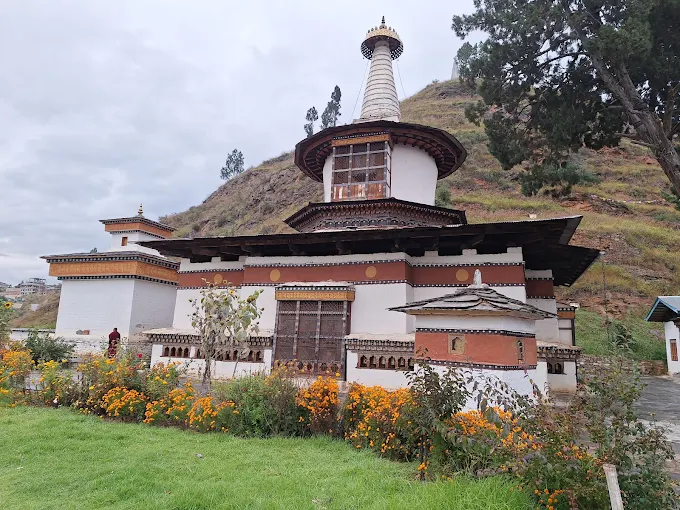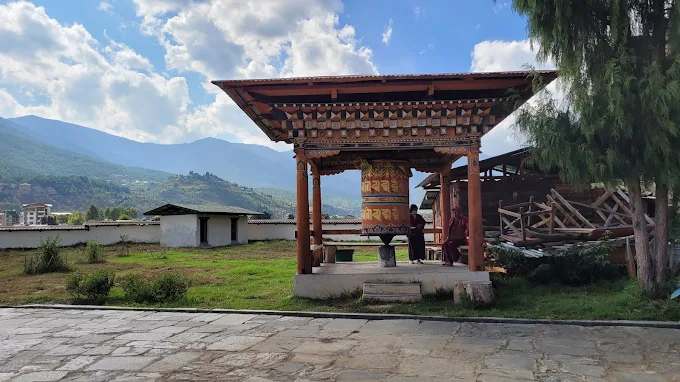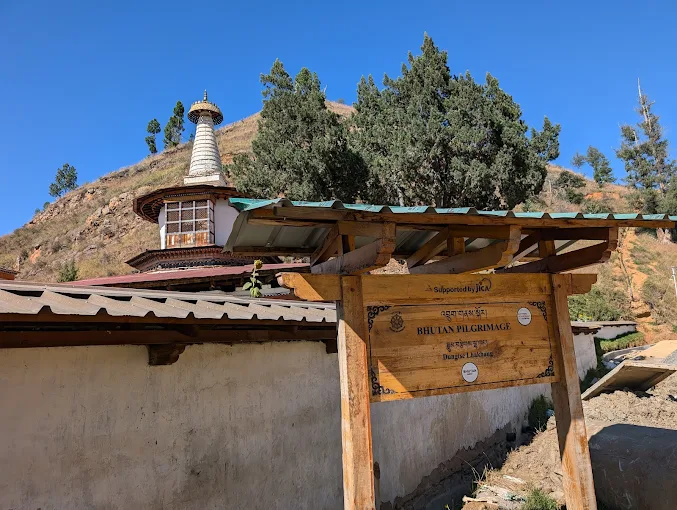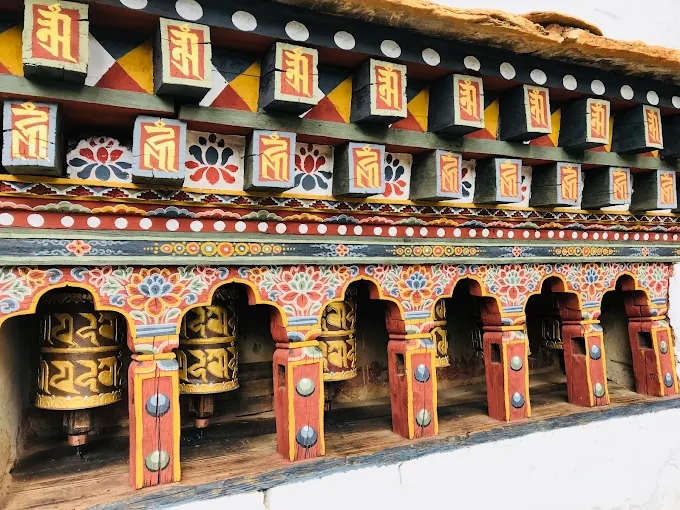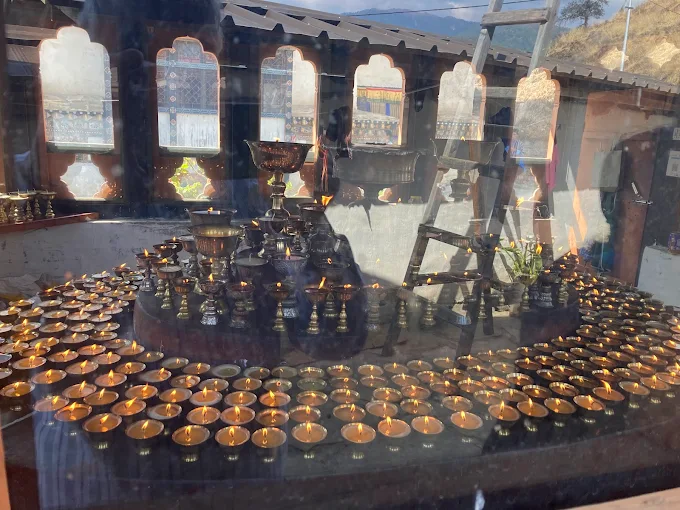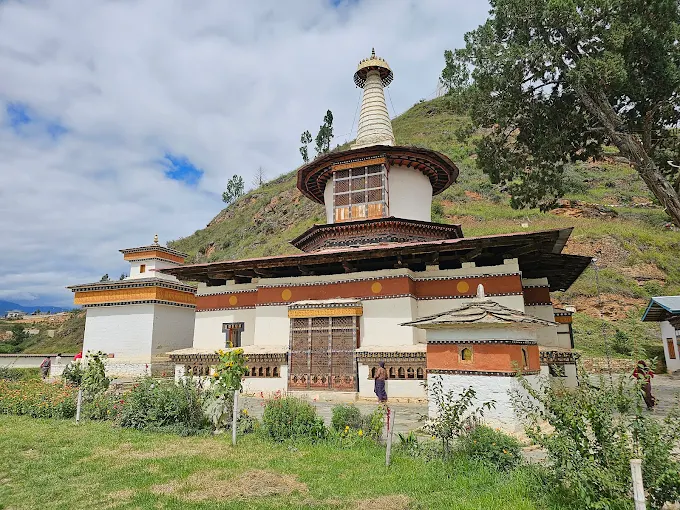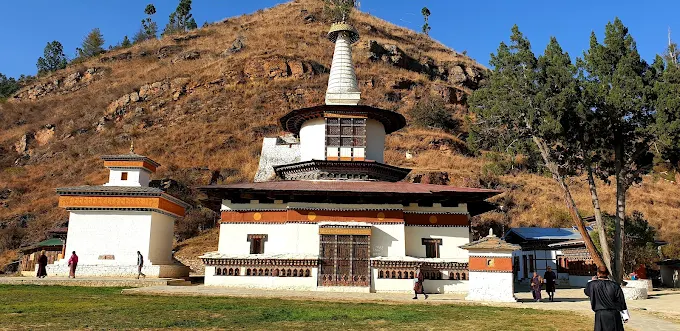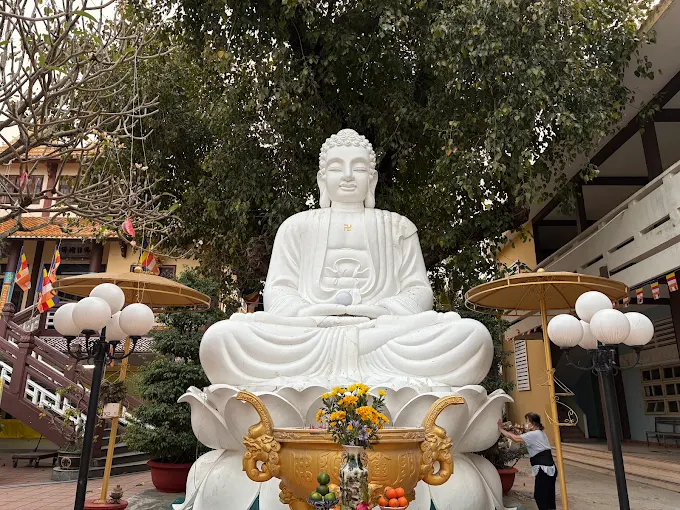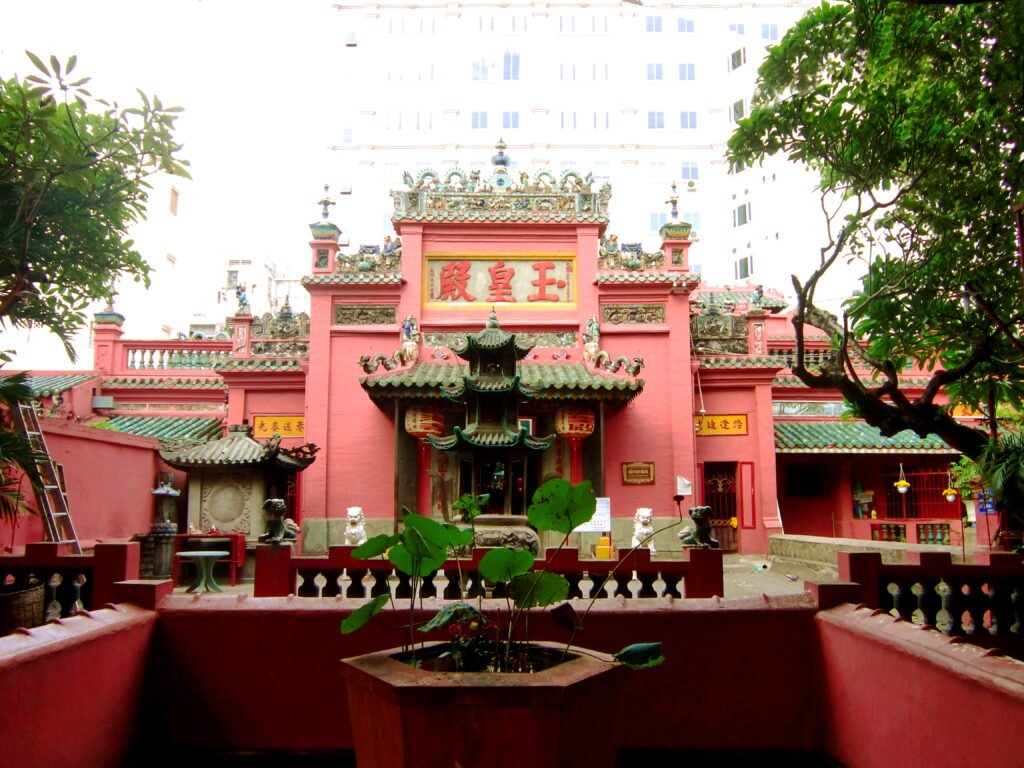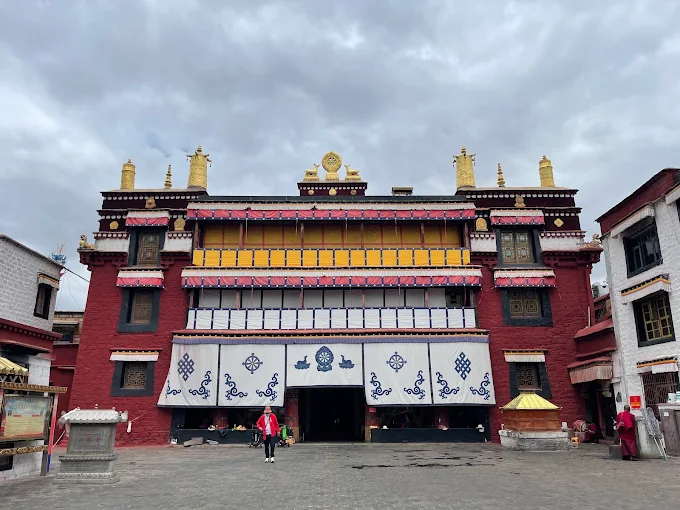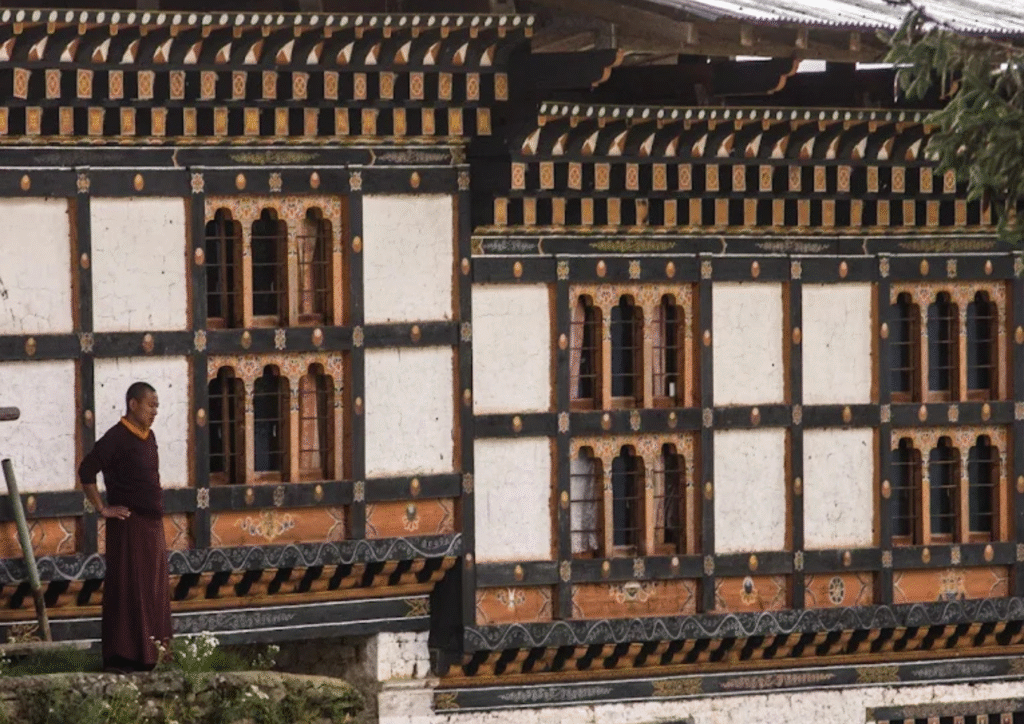Jangtsa Dumtseg Lhakhang: Chorten-Shaped Mandala of Paro’s Kagyu Legacy
As dawn brushes Paro Valley’s misty hills, Jangtsa Dumtseg Lhakhang rises across the Paro Chhu, its chorten-shaped silhouette aglow against a rugged backdrop. Within, a bronze Shakyamuni Buddha gazes beside Guru Rinpoche and Thangtong Gyalpo, their altar framed by vivid murals of tantric deities, lit by butter lamps’ flickering warmth. Steep wooden ladders lead to three floors—hell, earth, heaven—each a mandala layer painted with Avalokiteshvara and Mahakala. During Tshechu, masked dancers swirl in the courtyard, their steps echoing Drukpa Kagyu rhythms, while prayer wheels hum under prayer flags. Built in 1421 by Thangtong Gyalpo, the Iron Bridge Builder, to subdue a demoness, the temple’s central tower is chained to the earth, a testament to its mythic power. Restored in 1841 by the 25th Je Khenpo, it bears donors’ names carved on tree-trunk pillars. Nestled between Paro and Dopchari valleys, this lhakhang weaves meditation, art, and Sharchop devotion, offering a sanctuary where Bhutan’s spiritual pulse resonates.
Overview and Significance
Jangtsa Dumtseg Lhakhang, perched on a hill across Paro Chhu, stands as a Drukpa Kagyu masterpiece, its rare chorten shape and mandala design embodying centuries of spiritual triumph. This temple, a vibrant repository of Buddhist iconography, anchors Paro’s cultural and religious life.
Historical Roots and Legacy
In 1421, Thangtong Gyalpo, a Tibetan lama renowned for building eight iron bridges in Bhutan, erected Jangtsa Dumtseg Lhakhang to subdue a demoness haunting Paro Valley’s hills, according to local legend. Conceived as a mandala, its three floors—representing hell, earth, and heaven—were designed to counter serpentine and naga spirits, with the hill resembling a frog’s nose or a black snake. Restored in 1841 by the 25th Je Khenpo Sherab Gyeltsen, with Paro villagers’ aid, the temple’s tree-trunk pillars bear carved donor names, a lasting tribute. Thangtong Gyalpo’s Shangpa Kagyu influence, blended with Drukpa Kagyu, shapes its legacy. Key milestones include:
- 1421 Founding: Built by Thangtong Gyalpo to tame negative forces.
- 1841 Restoration: Sherab Gyeltsen rebuilt, preserving murals and structure.
- Chorten Design: Unique mandala form, chained to prevent flying to Tibet.
- Cultural Endurance: Remains a pilgrimage site despite ongoing renovations (2018–2024).
Cultural and Spiritual Significance
The lhakhang’s chorten shape, rare in Bhutan, marks it as a Drukpa Kagyu treasure, its murals a repository of Buddhist iconography rivaling Tibet’s grand monasteries. Positioned on a geomantic promontory between Paro Chhu and Do rivers, it symbolizes victory over malevolent spirits, fostering Paro’s spiritual harmony. Its Tshechu festival, with cham dances, draws Sharchop villagers, reinforcing cultural pride. The temple’s mandala design guides devotees through spiritual initiation, from hell’s trials to heaven’s enlightenment. Its significance includes:
- Drukpa Kagyu Hub: Preserves Thangtong Gyalpo’s teachings, blending Shangpa influences.
- Cultural Beacon: Tshechu unites Paro’s community in devotion.
- Mythic Power: Subdues demoness and naga spirits, ensuring valley prosperity.
- Artistic Legacy: Murals rival Bhutan’s finest, inspiring devotion.
Community and Global Connections
Jangtsa Dumtseg binds Paro’s Sharchop community through rituals and festivals, with villagers maintaining prayer wheels and supporting Tshechu. Its proximity to Paro town draws regional pilgrims, while its unique design attracts global travelers seeking Bhutan’s Kagyu heritage. The 1841 restoration, etched with donors’ names, reflects communal devotion, a tradition echoed in modern upkeep. Anecdotes highlight its impact:
- Local Unity: Villagers’ 1841 aid strengthened Paro’s spiritual bonds.
- Global Appeal: Travelers marvel at murals, sharing tales online.
- Pilgrim Draw: Monks guide visitors, fostering Kagyu understanding.
- Historical Echoes: Thangtong Gyalpo’s vulture blessing inspires devotion.
The lhakhang’s chorten form and mythic legacy set the stage for its architectural splendor, where sacred spaces mirror Drukpa Kagyu’s depth.
Architectural and Spiritual Features
Jangtsa Dumtseg Lhakhang’s chorten-shaped design and vivid murals blend Drukpa Kagyu reverence with Bhutanese artistry, its three floors a mandala of spiritual ascent. This section explores its physical and sacred essence.
Iconic Design and Structures
Perched at 2,285 meters between Paro and Dopchari valleys, the lhakhang’s whitewashed stone walls form a cylindrical chorten, topped with a white tower chained to prevent it from “flying to Tibet,” per local lore. Its three floors, connected by steep wooden ladders, represent hell, earth, and heaven, a mandala design unique in Bhutan. The courtyard, fringed by prayer wheels, overlooks Paro Chhu’s confluence with Do river, its geomantic promontory enhancing spiritual power. Key structures include:
- Chorten-Shaped Lhakhang: Cylindrical with a white tower, chained for mythic stability.
- Courtyard: Packed earth with prayer wheels, facing Paro’s hills.
- Tree-Trunk Pillars: 1841 restoration columns bear donors’ carved names.
- Meditation Hall: Ground-floor space for Five Buddhas’ contemplation.
Sacred Statues and Relics
The prayer hall’s altar hosts a bronze Shakyamuni Buddha, flanked by Guru Rinpoche, Thangtong Gyalpo, and Avalokiteshvara, their gold-inlaid forms glowing in dim light. The ground floor features Five Buddhas of Meditation, while the second floor displays Mahakala and Bardo deities, guiding souls through death’s transition. The third floor’s tantric deities—Guhyasamaja, Vajrabhairava, Cakrasamvara, Hevajra, Kalacakra, Vajravarahi, Hayagriva, Mahamaya—form a Shangpa Kagyu mandala. Key elements include:
- Shakyamuni Buddha: Central bronze statue, symbolizing enlightenment.
- Thangtong Gyalpo: Honors the founder’s bridge-building legacy.
- Mahakala: Second-floor protector deity, fierce in murals.
- Tantric Murals: Third-floor Shangpa deities, intricate and vibrant.
Artistry and Environmental Harmony
Crafted with local stone and cedar, the lhakhang’s tree-trunk pillars, carved with 1841 donors’ names, reflect Paro’s communal artistry. Karma Ghadri murals, painted with mineral pigments, depict 84 Indian and Tibetan saints, including Milarepa and Gampopa, their lotus and cloud motifs preserved against Paro’s humidity. The chorten’s alignment with Paro Chhu enhances its geomantic power, tying it to the valley’s sacred landscape. Notable features include:
- Artisan Craft: Paro painters restored 1841 murals, blending Shangpa and Drukpa styles.
- Environmental Ties: Chorten’s hill mimics a frog’s nose, subduing spirits.
- Preservation Efforts: Monks maintain murals, despite ongoing renovations (2018–2024).
- Symbolic Design: Mandala floors guide spiritual ascent, distinct from rituals.
The lhakhang’s sacred spaces, from chained tower to vibrant murals, cradle its rituals, inviting devotees into Drukpa Kagyu’s meditative heart.
Rituals and Practices
Jangtsa Dumtseg Lhakhang’s rituals, rooted in Drukpa Kagyu’s meditative traditions, weave chant, offering, and festival into a vibrant spiritual tapestry. This section explores its ceremonial life, fostering enlightenment for Paro’s community.
Daily and Unique Rituals
Each dawn, caretakers chant Drukpa Kagyu sutras like the Heart Sutra, their voices echoing through the chorten’s dim halls, as butter lamps illuminate Shakyamuni and Avalokiteshvara. Incense offerings, their sandalwood scent mingling with cedar, honor Thangtong Gyalpo’s legacy. Unique to the lhakhang, pilgrims climb steep ladders to meditate on each floor’s mandala, reflecting on hell’s trials, earth’s balance, and heaven’s clarity, guided by Mahakala’s protective presence. Key practices include:
- Morning Chants: Daily recitations of Kagyu texts, led by caretakers.
- Mandala Meditation: Floor-by-floor contemplation, unique to the chorten design.
- Incense Offerings: Daily rituals at the altar, purifying the space.
- Bardo Prayers: Weekly rites for souls in transition, tied to second-floor deities.
Festival Traditions
The spring Tshechu, held in March or April, transforms the courtyard with cham dances, where masked performers embody Cakrasamvara and Vajravarahi, honoring Drukpa Kagyu’s tantric roots. The annual Kagyu Monlam, a prayer festival, draws Paro’s Sharchop villagers, with monks reciting aspirations for peace under fluttering prayer flags. These festivals, vibrant with color, contrast daily rites, celebrating Kagyu wisdom. Highlights include:
- Tshechu Dances: Spring cham performances with lion and deer motifs.
- Monlam Prayers: Annual aspirations for global harmony, led by lamas.
- Losar Offerings: New Year butter lamps, blessing Paro’s community.
- Communal Feasts: Villagers share ema datshi post-festivals.
Community and Visitor Engagement
Caretakers, often elder monks, lead daily rites and guide visitors through the mandala’s floors, sharing Thangtong Gyalpo’s tales. Sharchop villagers maintain prayer wheels and organize Tshechu, weaving communal bonds. Visitors can join morning chants or Monlam prayers, using phone flashlights to view dim murals, immersing in Kagyu’s meditative pulse. Engagement includes:
- Visitor Chants: Guests join dawn sutras, learning Kagyu mantras.
- Festival Roles: Villagers prepare offerings, inviting visitors to observe.
- Guided Tours: Monks explain murals, fostering cultural understanding.
- Community Unity: Sharchop families host post-Tshechu gatherings.
The lhakhang’s rituals, vibrant with Kagyu tradition, invite exploration of its practical and cultural embrace, guiding visitors to Paro’s sacred heart.
Visitor Information
Jangtsa Dumtseg Lhakhang beckons travelers to Paro’s hills, offering practical guidance to engage with its chorten-shaped sanctity, from navigating its riverside path to immersing in its spiritual rhythm.
Navigating the Monastery
Across the Paro Chhu River from Paro town, the lhakhang perches on a hill forming a geomantic promontory between Paro and Dopchari valleys, a 10–20-minute walk from Paro’s main street. Cross the traditional bridge over Paro Chhu, follow the path past prayer flags, and ascend a gentle slope to the chorten’s white tower, visible near the National Museum’s road. Landmarks include the Paro Chhu’s confluence with Do river and the distant Paro Dzong. Navigational tips include:
- Route: Walk southeast from Paro town, crossing Paro Chhu’s bridge.
- Landmarks: Look for the National Museum and prayer flags en route.
- Walking Path: A 1-km trail, pleasant through Paro’s fields.
- Orientation: The chorten’s white tower signals the lhakhang.
Practical Details and Etiquette
The lhakhang’s address is Paro Valley, Paro District, Bhutan, open daily from 7:00 AM to 5:00 PM, with extended hours during Tshechu. Dress modestly, covering arms and legs, and remove shoes before entering; photography inside is restricted due to dim lighting and ongoing renovations (2018–2024), which may limit access. No entrance fee is required. Transport and safety details ensure a smooth visit:
- Address: Paro Valley, Paro District, Bhutan.
- Hours: 7:00 AM–5:00 PM, extended for Tshechu and Monlam.
- Etiquette: No altar photography; use phone flashlights for murals.
- Transport: 10–20-minute walk from Paro; taxis or buses to Paro town.
- Accessibility: Flat courtyard; steep ladders limit upper-floor access.
- Safety: Paro is safe; carry a flashlight for dim interiors.
Immersive Experiences and Surroundings
Visit at dawn to join sutra chants, where monks’ voices blend with butter lamp warmth, or attend spring Tshechu for cham dances honoring Thangtong Gyalpo. Nearby, Paro Dzong (1 km away) offers fortress grandeur, while the National Museum (500 m away) showcases Bhutanese artifacts. Paro’s weekend market, a short walk, offers Gho, Kira, and local crafts. Immersive highlights include:
- Chanting Sessions: Join morning sutras for Kagyu insight.
- Tshechu Dances: Observe spring cham dances, vibrant with motifs.
- Nearby Sites: Visit Paro Dzong or the National Museum.
- Local Flavor: Savor ema datshi at Paro’s market stalls.
The lhakhang’s gates open to its Drukpa Kagyu philosophy, where Paro’s sacred wisdom unfolds in vibrant depth.
Cultural and Spiritual Insights
Jangtsa Dumtseg Lhakhang’s essence lies in its Drukpa Kagyu roots and Paro’s mythic spirit, offering profound insights into Bhutan’s spiritual and cultural depth.
Philosophical Foundations
Drukpa Kagyu’s teachings, blending Mahamudra meditation with Shangpa influences via Thangtong Gyalpo, guide devotees toward enlightenment through the mind’s innate clarity. The lhakhang’s mandala design, with three floors representing hell, earth, and heaven, mirrors this path, guiding pilgrims from suffering to liberation. Mahakala’s protective presence and tantric deities like Cakrasamvara empower meditative practice, rooted in compassion. Key elements include:
- Mahamudra: Insight into mind’s clarity, practiced daily.
- Mandala Path: Floor-by-floor ascent reflects spiritual initiation.
- Compassion Focus: Aligns with Kagyu’s altruistic ethos.
Cultural and Symbolic Depth
The chorten’s chained tower, symbolizing victory over a demoness, embodies Drukpa Kagyu’s triumph over negative forces, distinct from ritual offerings. Murals of 84 saints, including Milarepa and Gampopa, weave Bhutanese artistry with Tibetan iconography, their lotus motifs signifying purity. The hill’s frog-like nose, per legend, enhances geomantic power, grounding Paro’s spiritual harmony. Symbolic highlights include:
- Chained Tower: Represents subduing malevolent spirits.
- Lotus Murals: Symbolize purity rising from strife.
- Kagyu Iconography: Depicts Milarepa, linking to lineage origins.
Community and Environmental Resilience
The lhakhang strengthens Paro’s Sharchop community through Tshechu and prayer wheel upkeep, fostering unity. Villagers’ 1841 restoration, with carved donor names, reflects enduring devotion, echoed in modern care despite renovations. Tree-planting around Paro Chhu aligns with Bhutan’s eco-conscious ethos, tying the temple to the valley’s pines. Key aspects include:
- Community Bonds: Sharchop villagers organize festivals, fostering unity.
- Eco-Stewardship: Pine plantings honor Bhutan’s environmental values.
- Cultural Resilience: Restoration tales inspire Paro’s devotion.
These insights weave a vibrant reflection on the lhakhang’s enduring role, beckoning travelers to its sacred embrace.
Why You Have to Get to Jangtsa Dumtseg Lhakhang
Jangtsa Dumtseg Lhakhang beckons as a chorten-shaped mandala in Paro’s sacred valley, its chained white tower and vibrant murals radiating Thangtong Gyalpo’s 1421 vision. Spring Tshechu’s masked dances, swirling with Cakrasamvara motifs, pulse with Drukpa Kagyu wisdom, while daily chants echo through floors of hell, earth, and heaven, guiding pilgrims across Paro Chhu’s bridge. This lhakhang, subduing a demoness with its mandala design, nurtures Paro’s Sharchop heart, its tree-trunk pillars bearing 1841 donors’ names. From Mahakala’s fierce gaze to the hill’s frog-like nose, it offers a rare glimpse into Bhutan’s Kagyu heritage. Travelers are invited to climb its steep ladders, where prayer flags flutter and murals whisper timeless devotion, unveiling Paro’s spiritual depth.
